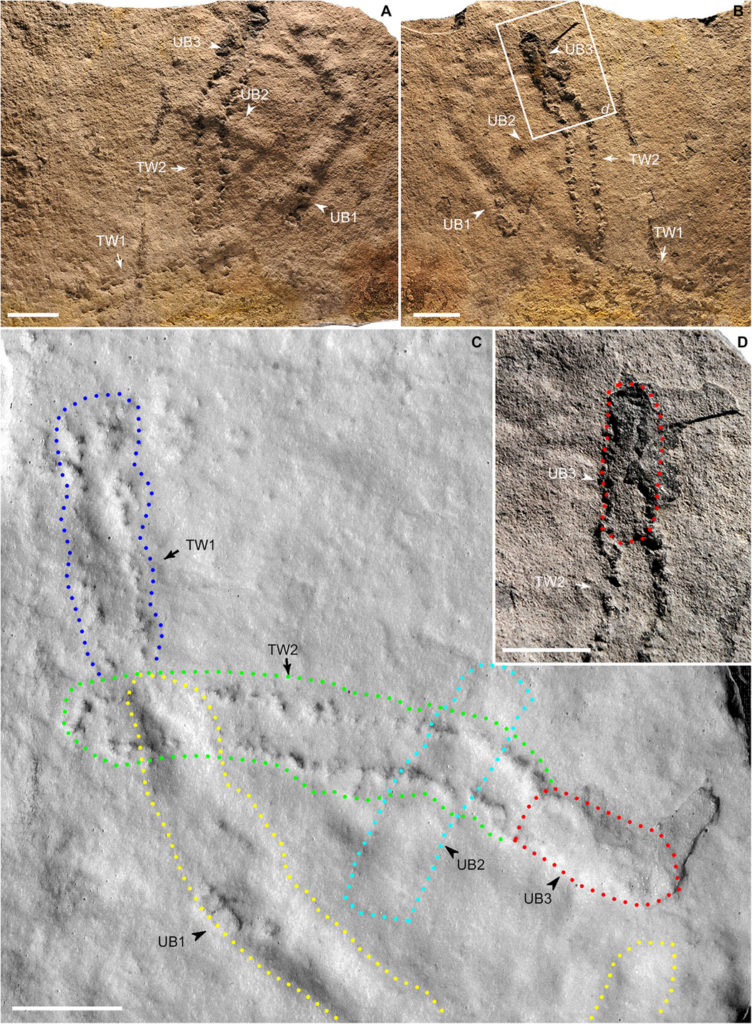@WFS,World Fossil Society,Riffin T Sajeev,Russel T Sajeev

Trackways and burrows excavated in situ from the Shibantan Member.
(A and B) Epirelief (top bedding surface) and hyporelief (bottom bedding surface), respectively. NIGP-166148. Trackways (TW1 and TW2) and undermat burrows (UB1 to UB3) are labeled. (C) Latex mold of (B), with trackways and burrows marked and labeled. (D) Enlargement of rectangle in (B), showing connection between TW2 and UB3 (marked). All photographs were taken with lighting from upper right. Scale bars, 2 cm. Figure produced by Z.C. and S.X. using Adobe Photoshop.
The oldest known footprints on Earth, left by an ancient creepy-crawly more than 500 million years ago, have been discovered in China.
The tracks were left by a primitive ancestor of modern-day insects or worms, according to scientists. Precisely what the creature looked like is a mystery, though: nothing this old with legs has been discovered to date.
Prof Shuhai Xiao, a geobiologist at Virginia Tech University and senior author of the research, said the finding brings scientists closer to understanding what creatures were the first to evolve pairs of legs.
“Animals use their appendages to move around, to build their homes, to fight, to feed, and sometimes to help mate,” he said, adding that the movement of sediments by the first legged creatures could have had a major impact on the Earth’s geochemical cycles and climate. “It is important to know when the first appendages appeared, and in what animals, because this can tell us when and how animals began to change to the Earth in a particular way.”
Previously, scientists had discovered footprints as old as 530-540m years, but none predating the Cambrian period, which also began at this time and marked an explosion in the diversity and complexity of life on Earth. The latest prints date to the Ediacaran period, whose sparse fossil record is populated with soft-tissued creatures including worms and organisms that resembled tiny immobile bags.
The fossils are just a few millimetres in width and Xiao’s team spotted them after painstakingly tilting rock slabs at different angles so the sunlight would illuminate any subtle traces left by ancient bugs.
“The key challenge is to get the lighting right so that the fossils stand out against the background, because the fossils have very low relief,” said Xiao.
On closer analysis, the team found the marks comprise two rows of imprints that they believe were left by a creature scurrying along a riverbed, at a time when life had not yet colonised dry land. The trackways also appear to be connected to burrows, suggesting the creatures periodically tunnelled down into the sediments, perhaps to mine oxygen and microbes as food.
The scientists are unsure whether the creature had many legs or just two, and whether it was a member of the arthropod group, which includes bumblebees and spiders, or annelids, which contains modern-day bristle worms. “Unless the animal died and was preserved next to its footprints,” said Xiao, “it is hard to say who made the footprints.”
The findings are published in the journal Science Advances.
Source: The guardian.com



 May 28th, 2020
May 28th, 2020  Riffin
Riffin  Posted in
Posted in  Tags:
Tags: 